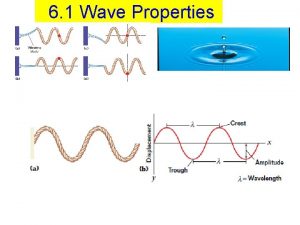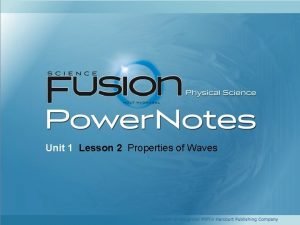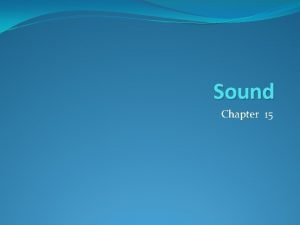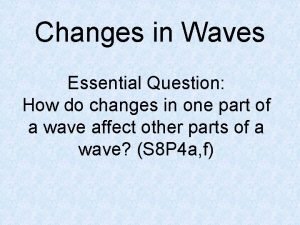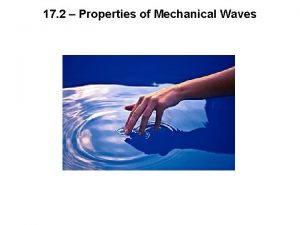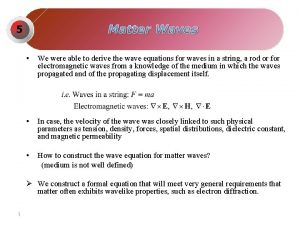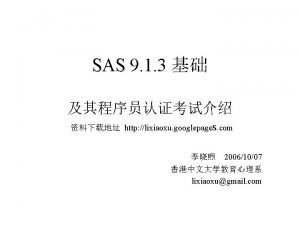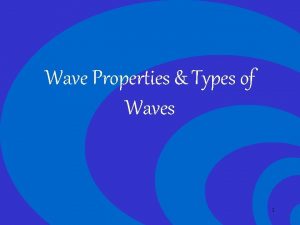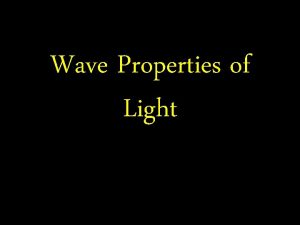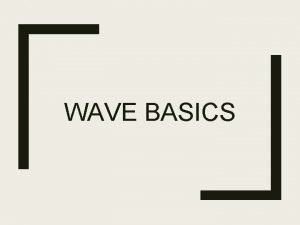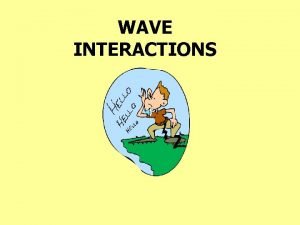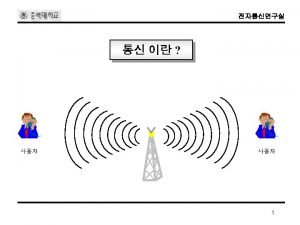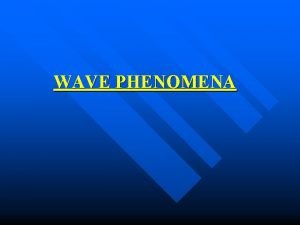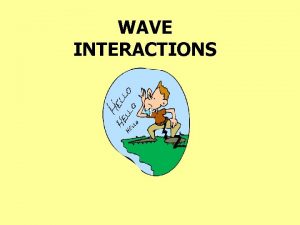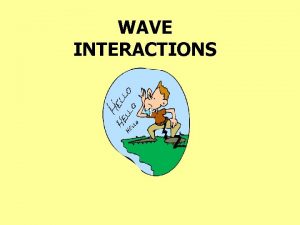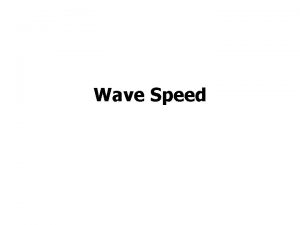6 1 Wave Properties SAS Curriculum Pathways Wave




























- Slides: 28

6. 1 Wave Properties

SAS Curriculum Pathways Wave Properties

Wave Motion What happens if you drop a pebble into the water? The disturbance created by the pebble generates water waves that travel away from the disturbance

Wave is the Motion of a Disturbance ØThis disturbance causes water on the surface near that point to move, which in turn causes points farther away to move. ØIn this way, the waves travel outward in a circular pattern away from the original disturbance.

Wave is the Motion of a Disturbance ØThe water is the MEDIUM through which the disturbance travels. ØThe medium does not actually travel with the waves. ØAfter the waves have passed, the water returns to its original position.

MECHANICAL WAVES = need MEDIUM ØMost of the waves (sound waves, spring waves…) need MEDIUM (air, water…)

MECHANICAL WAVES = need MEDIUM ØWe call them MECHANICAL WAVES

ELECTROMAGNETIC WAVES = DO NOT need MEDIUM ØThey can travel through vacuum

Wave Types PULSE • Non – repeating wave • Only single disturbance PERIODIC WAVE • Repeating wave • Period = recurring at regular intervals

Describing Waves

CREST • The highest point on the waves

Trough • The lowest point on the waves

Wavelength • The distance between successive crests or troughs

Amplitude • The height of the wave

Frequency (f) measured in Hz • How often the waves and their source vibrate per second (how many wavelengths per second)

Period (T) measured in • The time interval between vibrations (of the seconds wavelength) • Inverse of FREQUENCY

1. 25 Hz 0. 800 s 256 Hz 3. 91 x -3 10 s 0. 25 Hz

Transverse Waves • A wave whose particles vibrate perpendicularly to the direction of the wave’s motion. • The spring is pulled sideways (up) while the pulse travels in the perpendicular direction (to the right)

Longitudinal Waves • When several turns of the spring are compressed and let go • The disturbance is in the same direction as the pulse will travel

Longitudinal Wave • A wave whose particles vibrate parallel to the direction the wave is traveling

Wave REFLECTION • When a wave encounters a boundary (shoreline, different medium…) and it is reflected back

Wave REFRACTION • When a wave hits a boundary at an angle OR the wave enters a new medium • The wave’s speed is changed AND it is BENT

The Wave Equation Speed is equal to displacement divided by the time it takes to undergo that displacement For waves, a displacement of one wavelength (λ) occurs in a time interval equal to one period of the vibration (T).

The Wave Equation Because frequency and period are inversely related, Substituting this frequency relationship into the previous equation for speed gives a new equation for the speed of a wave.

vibrates with a frequency of 262 Hz. Assuming the speed of sound in air is 343 m/s, find the wavelength of the sound waves produced by the string.

Practice Problems 6. 1. 1 If f doubles, λ is halved If f halves, λ is doubled 200 Hz 1. 5 m

Answer the Concluding Questions

6. 1 Review Questions (all)
 Sas curriculum pathways
Sas curriculum pathways Easy sas core classes
Easy sas core classes Standards aligned system pa
Standards aligned system pa Difference between intensive and extensive properties
Difference between intensive and extensive properties Chemical property of water
Chemical property of water Wave properties lesson 2
Wave properties lesson 2 Properties of sound
Properties of sound Changes in wave properties sorting activity answer key
Changes in wave properties sorting activity answer key Property of mechanical waves
Property of mechanical waves Properties of matter wave
Properties of matter wave Sound waves are electromagnetic waves. true false
Sound waves are electromagnetic waves. true false Long waves and short waves
Long waves and short waves Difference between full wave and half wave rectifier
Difference between full wave and half wave rectifier Difference between transverse wave and longitudinal wave
Difference between transverse wave and longitudinal wave Define half wave rectifier
Define half wave rectifier Full wave rectifier circuit
Full wave rectifier circuit Earthquake p-wave and s-wave travel time graph
Earthquake p-wave and s-wave travel time graph Full wave rectified sine wave fourier series
Full wave rectified sine wave fourier series Wave wave repeating
Wave wave repeating Wave wave repeating
Wave wave repeating Half wave symmetry fourier series
Half wave symmetry fourier series Mechanical and electromagnetic waves venn diagram
Mechanical and electromagnetic waves venn diagram Characteristics of mechanical waves
Characteristics of mechanical waves Wavelength formula triangle
Wavelength formula triangle Pathways modesto
Pathways modesto Nys graduation pathways
Nys graduation pathways Dysmetria
Dysmetria South forsyth high school pathways
South forsyth high school pathways Sdsu pathways
Sdsu pathways
